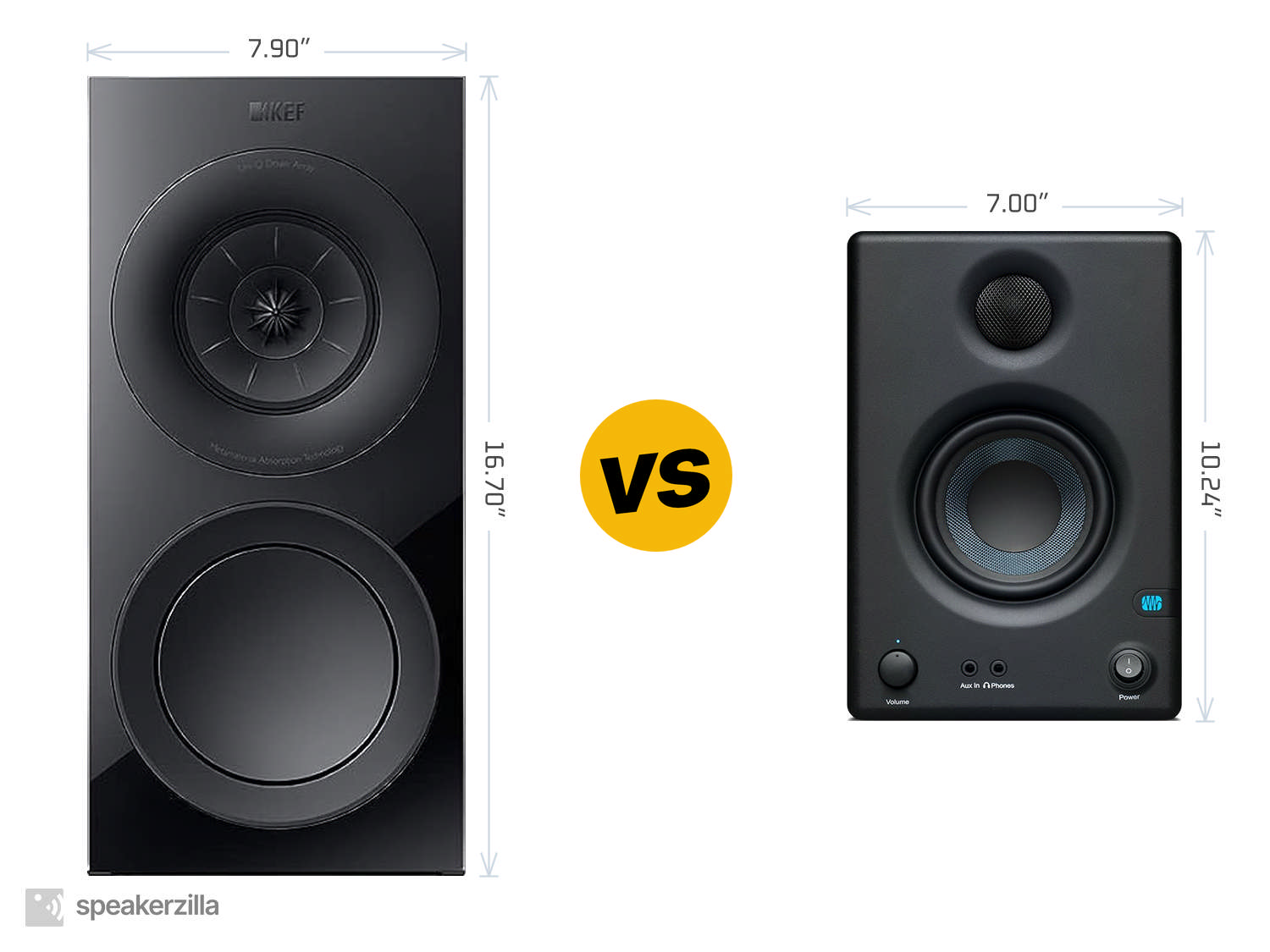KEF R3 Meta vs. Presonus Eris E3.5

| KEF R3 Meta Bookshelf Speakers | Presonus Eris E3.5 3.5” Near Field Studio Monitor |
| MSRP | |
| $2200 | $100 |
| Dimensions (H × W × D) | |
|
16.70” × 7.90” × 13.50” 424mm × 201mm × 343mm |
10.24” × 7.00” × 7.68” 260mm × 178mm × 195mm |
| Power Type | |
| Passive | Powered |
| Frequency Response | |
| 58-28,000 Hz | 80-20,000 Hz |
| ASR Score | |
| n/a | 1.5 |
| ASR Score w/Subwoofer | |
| n/a | 4.3 |
|
Amazon.com
|
Amazon.com
|
Key Takeaways
TLDR Summary: In the world of high-fidelity audio, the KEF R3 Meta bookshelf speakers represent a sterling example of engineering finesse, blending KEF's signature Uni-Q driver with Metamaterial Absorption Technology for a pristine, detailed soundscape. In contrast, the PreSonus Eris E3.5 studio monitors offer a more budget-conscious option for burgeoning audiophiles and home producers. The Eris E3.5 provides a straightforward, honest sound with built-in tuning options to adapt to various environments. While the R3 Meta aims at the audiophile seeking lush sonic immersion, the Eris E3.5 courts those desiring functional accuracy without breaking the bank.
Speaker Comparison
When we navigate through the vast seas of high-quality audio equipment, it's essential to recognize that, although both destined to produce sound, not all speakers are crafted with the same intentions. The KEF R3 Meta bookshelf speakers and the PreSonus Eris E3.5 near-field studio monitors are two such examples, each designed with a distinct purpose in mind that influences their performances in various audio environments. The former, hailing from KEF's acclaimed R Series, is a premium home audio solution, while the latter serves as an entry-level studio monitor for aspiring sound engineers and producers.
The Design Philosophy: Fidelity vs. Functionality
KEF's R3 Meta is a masterpiece that screams high-fidelity. With its sleek design and the brand's proprietary Uni-Q driver array, the speaker aims to deliver a detailed and spacious soundstage, making it a favorite for audiophiles seeking an immersive listening experience. In contrast, the PreSonus Eris E3.5 has a more utilitarian design. They're built with the intention of providing clear and accurate sound reproduction for critical listening scenarios, which is paramount for audio production and mixing.

 (at Amazon.com)
(at Amazon.com)The Sound Quality: Clarity and Detail vs. Flat Response
Sound quality is invariably the heart of the matter. The R3 Meta, with its sophisticated Meta material technology and a more significant driver size, offers richer bass, more precise mids, and crisper highs. The goal is to envelop the listener in a more lifelike sound. The Eris E3.5, though smaller in driver size, strives for a flat frequency response, giving audio professionals a true sense of their mix, which can be crucial for creating content that translates well across various listening systems.
Power and Performance: Room-Filling vs. Intimate Spaces
Power handling is another domain where these two contenders diverge. The KEF R3 Meta is designed to command a room, with a power range that can easily fill a medium to large space with captivating sound. This capability makes it an excellent choice for those who wish to experience the full dynamic range of their music. On the flip side, the PreSonus Eris E3.5 monitors are tailored for intimate settings, like home studios or small workspaces, where the emphasis is on precision rather than power.

 (at Amazon.com)
(at Amazon.com)What's more, the impedance and sensitivity of these speakers tell a story of their intended use. The KEF R3 Meta boasts a higher impedance and sensitivity, suggesting they benefit from a quality amplifier to unlock their full potential. Conversely, the Eris E3.5 has a built-in amplifier, which means they offer convenience and simplicity, particularly appealing to those with space or budget constraints.
Compare to similar speakers
The Price: Investing in Sound
Affordability is a crucial factor for many, and the KEF R3 Meta and PreSonus Eris E3.5 sit at markedly different points on the price spectrum. The R3 Meta commands a premium, being a high-end choice for the discerning audiophile willing to invest in superior sound quality and build. The Eris E3.5, however, presents an attractive proposition for those on a tighter budget, offering a transparent window into the world of professional audio without breaking the bank.
In conclusion, while the KEF R3 Meta and the PreSonus Eris E3.5 may both be speakers, they cater to vastly different audiences. The R3 Meta is a testament to KEF’s legacy in providing audiophile-grade sound for the home listener seeking a sublime sonic experience. In contrast, the Eris E3.5 is a gateway for budding producers and mixers to hone their craft with honest and reliable sound reproduction. Both are remarkable in their rights and stand as testaments to the diverse and personalized nature of listening.
- KEF R3 Meta reviews and FAQs
- Presonus Eris E3.5 reviews and FAQs
Check Current Prices: |
|
|
Amazon.com
|
Amazon.com
|
Affiliate Disclosure: As an Amazon Associate, we earn from qualifying purchases.

